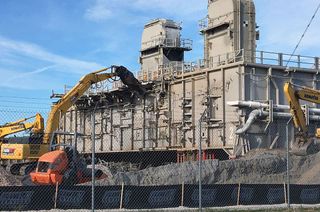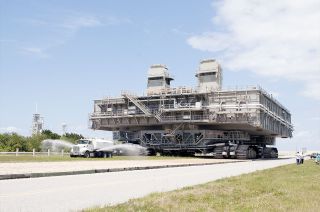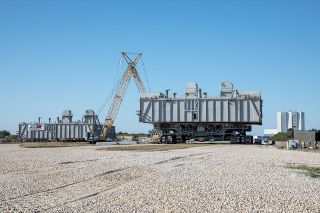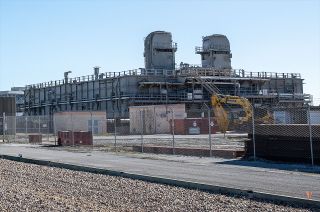Out of space, NASA is demolishing Apollo and space shuttle launch platform

One of the three large steel platforms that supported the launch of NASA's Apollo and space shuttle missions is now being demolished — due to a lack of space.
Fifty years ago this month, Mobile Launch Platform-2 (MLP-2, or as it was then referred to, Mobile Launcher-2 or ML-2) provided the surface from where the Apollo 14 crew left Earth to land on the moon. Fifteen years later, MLP-2 was the literal "surly bonds of Earth" from where the space shuttle Challenger's STS-51L crew tragically lifted off for the last time.
Given its role in those two missions, and the 49 other Apollo, Skylab and space shuttle launches that it supported between 1968 and 2011, it might be expected that MLP-2 would be retired as a museum artifact. Or if not that, it might continue to serve some purpose, as the two other Apollo and shuttle legacy mobile launch platforms have and are doing.
But MLP-2 is being destroyed.
Related: NASA's megarocket mobile launcher crawls to the launch pad for moon mission prep

"We're getting rid of MLP-2 now not because there were no customers [for its use]. We're getting rid of it because we're running out of parking places," said Scott Tenhoff, project manager for MLP-2's demolition at Kennedy Space Center. "That there's a contract out now to build Mobile Launcher-2, something had to go."
"We ran out of parking spots, so that's why we chose to get rid of MLP-2," Tenhoff said in an interview with collectSPACE.com.
Get the Space.com Newsletter
Breaking space news, the latest updates on rocket launches, skywatching events and more!
Between 1963 and 1965, Ingalls Iron Works built three mobile launchers to transport and support the launch of NASA's Saturn V and Saturn IB rockets. When the Apollo program ended, the mobile launchers were stripped of their launch umbilical towers and became mobile launch platforms (MLPs) used by the space shuttle. (Portions of the ML-2 and ML-3 umbilical towers were used to build the fixed service structures used to launch the space shuttle.)
For the Artemis program, NASA's current effort to return astronauts to the moon and then eventually land humans on Mars, the legacy mobile launch platforms were deemed incapable of supporting the combined mass of the agency's new Space Launch System (SLS) rocket and an umbilical tower to support its launch. A new mobile launcher, ML-1 (not to be confused with the Apollo ML-1, which became the shuttle program's MLP-3) was completed in 2018.
Construction of a new Artemis ML-2 began in July 2020, and when it is complete, the available ML and MLP parking spots inside and around the Vehicle Assembly Building (VAB) will be taken.
"The only other place we have mounts would be at the launch pad, but it [MLP-2] would be in the way if we left it at the pad," said Tenhoff.
So the 25-foot-high, 160-foot-long and 135-foot-wide (8 by 50 by 40-m) platform from where the Apollo 9 and Apollo 12 crews left the planet, where the first U.S. space station, Skylab, departed for Earth orbit and from where every space shuttle orbiter but the first (Columbia) began its first mission will soon be no more. Frank-Lin Services of Brevard was contracted by NASA to demolish MLP-2.
"They are going to use excavators with hydraulic shears," Tenhoff described. "What they're basically going to do is to cut it down in size, top to bottom from the outside, and just keep trimming it down."
The whole process is expected to take about a month.

According to a statement provided by NASA, an opportunity was extended to outside sources like the Smithsonian to gage interest in keeping any part of MLP-2 for historic preservation purposes. "The agency did not get any responses to the query to preserve any part of the MLP-2, therefore the decision was ultimately made to move on with the demolition," a NASA spokesperson said.
"To my knowledge there is nothing small enough or significant enough," said Tenhoff. "If you've never been inside one of the MLPs, it's all equipment for the job that it does. So to me, there's not much really to salvage unless you're going to have a couple of thousand pound pieces of plate that might have a significant MLP '2' number on it," he said.
At present, there are no plans for MLP-2's twin siblings to meet the same fate.
MLP-1 (ML-3) is presently being loaded with concrete blocks to simulate the mass of the SLS rocket and its launch umbilical tower. Once it is heavy enough, MLP-1 will be picked up by one of NASA's two crawler-transporters and driven along the river rock-covered crawlerway that extends from the VAB to the launch pad. This "conditioning" will ensure the crawlerway is ready for the weight of the SLS.
"So far we have done our first phase of rolling and when we are all done, MLP-1 will be saved," said John Giles, project manager for the crawler transporters. "We will store it in High Bay 1 in the VAB and it will be used again for crawlerway conditioning. At some point down the road, we'll have to condition the crawlerway again."

MLP-3 (ML-1), which supported the launches of the first humans to walk on the moon (Apollo 11) and the final space shuttle mission (STS-135), is currently being reverted to its shuttle-era configuration after being briefly leased to and modified by Northrop Grumman for use with the company's proposed, but now canceled, OmegA rocket.
"Probably by the end of this year, it [MLP-3] is going to be moved back into High Bay 2 inside the VAB and it will be kept there," said Tenhoff.
Click through to collectSPACE to see a montage of photographs from the 51 missions that Mobile Launch Platform-2 supported from 1968 to 2011.
Follow collectSPACE.com on Facebook and on Twitter at @collectSPACE. Copyright 2021 collectSPACE.com. All rights reserved.
Join our Space Forums to keep talking space on the latest missions, night sky and more! And if you have a news tip, correction or comment, let us know at: community@space.com.

Robert Pearlman is a space historian, journalist and the founder and editor of collectSPACE.com, an online publication and community devoted to space history with a particular focus on how and where space exploration intersects with pop culture. Pearlman is also a contributing writer for Space.com and co-author of "Space Stations: The Art, Science, and Reality of Working in Space” published by Smithsonian Books in 2018. He previously developed online content for the National Space Society and Apollo 11 moonwalker Buzz Aldrin, helped establish the space tourism company Space Adventures and currently serves on the History Committee of the American Astronautical Society, the advisory committee for The Mars Generation and leadership board of For All Moonkind. In 2009, he was inducted into the U.S. Space Camp Hall of Fame in Huntsville, Alabama. In 2021, he was honored by the American Astronautical Society with the Ordway Award for Sustained Excellence in Spaceflight History.

